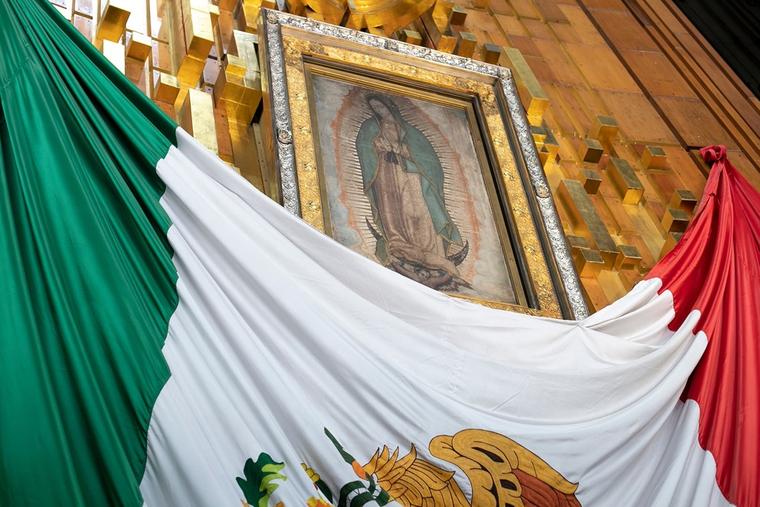- Feb 5, 2002
- 166,616
- 56,251
- Country
- United States
- Faith
- Catholic
- Marital Status
- Married
- Politics
- US-Others
Indigenous storytelling traditions heralded the mass conversion that followed St. Juan Diego’s encounter with Mary.
Guadalupe and the Flower World Prophecy: How God Prepared the Americas for Conversion Before the Lady Appeared
By Joseph Julián González and Monique González
Sophia Institute Press, 2023
249 pages, $18.95
To order: sophiainstitute.com
Within 10 years of Our Lady of Guadalupe’s appearance to a peasant, Juan Diego, on a hilltop near Mexico City in 1531, between 9 and 10 million of his fellow Indigenous people, hitherto adamantly polytheistic and suspicious of the conquering Spaniards’ religion, converted to the Catholic faith. The credit for this mass conversion, the largest in history, usually goes to the striking image of Our Lady. Indigenous in appearance herself, she miraculously appeared on Juan Diego’s tilma, or cloak, on Dec. 12, 1531, an anniversary celebrated in the Americas as her feast day.
But, in fact, few of the new converts, many of whom had walked for days through rough terrain to receive baptism and other sacraments from a handful of scattered Spanish missionary priests, ever saw the tilma, then lodged in a hastily built chapel on Tepeyac Hill, where Juan Diego had experienced his visions.
Why did they suddenly embrace the faith? Guadalupe and the Flower World Prophecy offers a compelling answer to that question.
The husband-and-wife authors argue that it was actually the story of Juan Diego’s encounters with Our Lady over four December days that moved those millions to conversion. It was a story told — or rather, sung, they believe — in Nahuatl, the language of the Nahua people (including the group we now know as the Aztecs), who had settled in central Mexico during the centuries preceding Hernán Cortés’ conquest of the area in 1519. Nahuatl was Juan Diego’s only language (he spoke no Spanish). The story traveled far — quickly — because the Nahua had a long and vibrant tradition of storytelling through song, dance and musical instruments, and they trained their children, as the Spanish colonists documented, in singing and memorization.
Continued below.

 www.ncregister.com
www.ncregister.com
Guadalupe and the Flower World Prophecy: How God Prepared the Americas for Conversion Before the Lady Appeared
By Joseph Julián González and Monique González
Sophia Institute Press, 2023
249 pages, $18.95
To order: sophiainstitute.com
Within 10 years of Our Lady of Guadalupe’s appearance to a peasant, Juan Diego, on a hilltop near Mexico City in 1531, between 9 and 10 million of his fellow Indigenous people, hitherto adamantly polytheistic and suspicious of the conquering Spaniards’ religion, converted to the Catholic faith. The credit for this mass conversion, the largest in history, usually goes to the striking image of Our Lady. Indigenous in appearance herself, she miraculously appeared on Juan Diego’s tilma, or cloak, on Dec. 12, 1531, an anniversary celebrated in the Americas as her feast day.
But, in fact, few of the new converts, many of whom had walked for days through rough terrain to receive baptism and other sacraments from a handful of scattered Spanish missionary priests, ever saw the tilma, then lodged in a hastily built chapel on Tepeyac Hill, where Juan Diego had experienced his visions.
Why did they suddenly embrace the faith? Guadalupe and the Flower World Prophecy offers a compelling answer to that question.
The husband-and-wife authors argue that it was actually the story of Juan Diego’s encounters with Our Lady over four December days that moved those millions to conversion. It was a story told — or rather, sung, they believe — in Nahuatl, the language of the Nahua people (including the group we now know as the Aztecs), who had settled in central Mexico during the centuries preceding Hernán Cortés’ conquest of the area in 1519. Nahuatl was Juan Diego’s only language (he spoke no Spanish). The story traveled far — quickly — because the Nahua had a long and vibrant tradition of storytelling through song, dance and musical instruments, and they trained their children, as the Spanish colonists documented, in singing and memorization.
Continued below.

How Our Lady of Guadalupe Miraculously Fulfilled a Prophecy
Indigenous storytelling traditions heralded the mass conversion that followed St. Juan Diego’s encounter with Mary.
